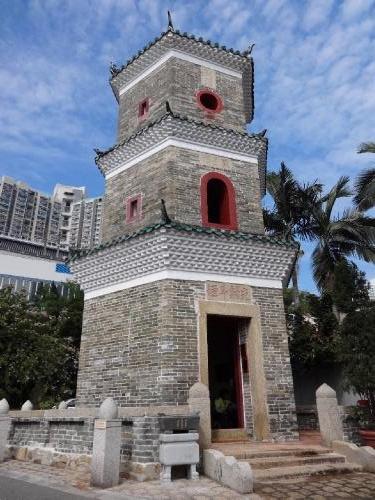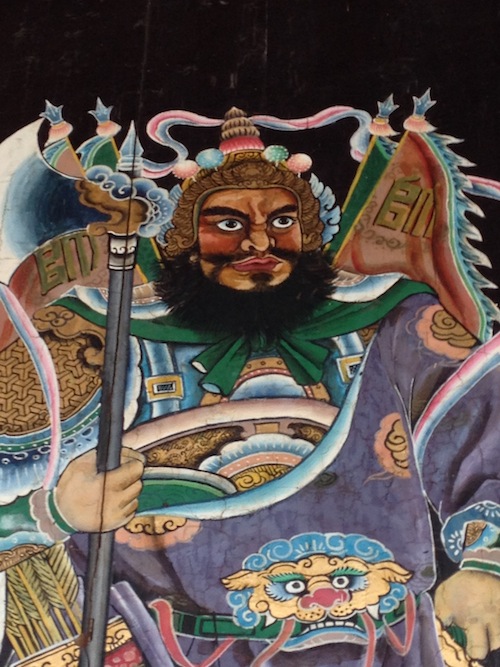It would be easy to spend a holiday in Hong Kong and not venture beyond the Island or neighbouring Kowloon, but our Lonely Planet guide suggested a walk in the New Territories that would take us back in time.
Half an hour away from our hotel on the efficient MTR railway lies the modern station and residential towers of Tin Shui Wai, and just a short walk from there the sometimes ramshackle village of Ping Shan. The Ping Shan Heritage Trail uncovers the story of the Tang clan, a people who arrived in this fertile part of the country during the late Yuan dynasty many centuries ago but, stepping from the train, it was difficult to imagine that much remained of that time in such an urban environment.
However, we were proved wrong at the start. Tsui Shing Lau is Hong Kong’s oldest pagoda, believed to have been built in 1486 and now composed of three grey storeys. Later in the walk we saw old pictures of it standing proud and alone in the countryside with just the occasional shack for company; today it’s overlooked by tower blocks and the metro line that carves its way across the landscape. A local woman parked on a chair inside welcomed us warmly, gabbled away in Chinese and smiled as we ooohhhed and ahhhed and pretended we understood every word. I sensed that she didn’t get many visitors and was keen to make the most of the company.

We walked on through unpromising lorry parks and the sort of shabbiness I’d come to expect in Hong Kong until we arrived at Sheung Cheung Wai, the remains of a 200-year-old walled village. Very little is left of it today as modern, unattractive development has overtaken it, but there was just enough in its bones to give us a sense of what it was once like. The old pattern of the village remains, the tight alleys barely separating the houses but providing useful shade on a hot day.
Arriving at the Yeung Hau Temple I was beginning to feel that the heritage trail was scraping the bottom of the historical barrel, for the majority of the buildings and ruins were mostly shadows and shells. But then, in the village square, surrounded by yet more modern buildings, we came face to face with two, out-of-this-world ancestral halls. The Tang Ancestral Hall is the oldest, built in about 1273, with three halls, two courtyards, beautiful carvings and colourful decorative touches. It would’ve been the centre of clan life back in the day and it’s still an imposing sight many centuries later. Beside it is the 15th century Yu Kiu Ancestral Hall, which is almost as grand as its neighbour.

A little further on we came across the beautiful Kun Ting Study Hall, once used as both an ancestral hall and a place of study by clan members preparing to join the imperial civil service. Built in the 1870s, it boasts more examples of great craftsmanship – but none so fine as the neighbouring Ching Shu Hin. Built at the same time as a guesthouse for scholars and important visitors, it’s rich in carved panels, murals, patterned grilles, colourful tiles and other excellent examples of arts and crafts. My faith in the heritage trail was restored.
A short walk later, uphill in the humidity and beyond some open spaces largely used for fly tipping, we visited the Ping Shan Tang Clan Gallery cum Heritage Trail Visitor Centre. Housed in a handsomely restored old police station, it has a small but enthralling museum about the Tang clan and the history of the area. Only when we looked at the old photos there did we realise how much development has changed the landscape in recent years. Aerial photos show very clearly how Ping Shan has become surrounded by block after block of housing and industry. Long gone, for better or worse, are the fields that once supported life in these parts…

We caught the train back to Kowloon and had an hour or two by the pool at the hotel. For our last night in the city we treated ourselves to a trip over to the Island on the Star Ferry, which offered magical views of the city lit up around us. We ate Cantonese at Cuisine Cuisine in the IFC mall – it was a bit lacking in atmosphere – and then headed up to LKF and Soho again for some drinks. Around us, ex-pats were getting horribly drunk, locals were enjoying themselves, a wizzened old lady, doubled up with age, wandered about begging for a few coins. Most didn’t even realise she was there. Friday night in the heart of Hong Kong’s nightlife zone is pretty much what it’s like in any other big city. The big difference is that I didn’t feel anywhere near as threatened by roaming bands of drunk troublemakers as I would in, say, London. And for that, I was very grateful.
But as we prepared to pack up and leave, I wondered how long this characterful district would survive, for protestors had pinned posters to lampposts and walls warning us that developers had plans to rip the life and soul out of the district to make way for yet more towers. Another piece of Hong Kong’s heritage at risk…

